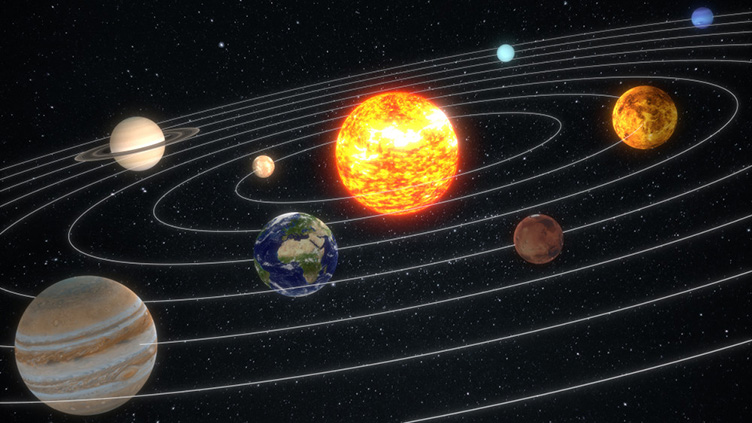Beyond planetary chaos thanks to geology
In the introduction of his treatise on probability of 1812, Pierre-Simon de Laplace considered the possibility of modeling the entire universe in a single equation (the laws of gravitation). Using only the knowledge of the current initial conditions, one could then find all the past and predict all the future. Henri Poincaré showed 80 years later the limits of this approach by discovering the possibility of chaotic movements, where a small variation of the initial conditions results by a wide deviation in the solutions.
As Jacques Laskar showed in 1989, The solar system is chaotic, and Laplace’s paradigm of determinism does not apply to it. The validity of the solutions of gravitational models of the solar system can not extend beyond 60 million years (Ma), not only because of the limitations in the determination of the initial conditions and parameters of the model, but more fundamentally because of its chaotic nature. Solutions diverge exponentially, multiplying uncertainties by a factor of 10 every 10 million years (fig.1).

In an article published in PNAS (Olsen et al., 2019), a multidisciplinary international team including Jacques Laskar (Research Director at the CNRS, IMCCE, Paris Observatory, PSL Research University, Sorbonne University) shows how the analysis of ancient geological data allows to go beyond the horizon of predictability of the solar system, and to retrieve its state 200 Ma ago.
According to the theory of Milankovitch Milankovitch (1941), a part of the large climatic changes of the past is due to the variations of the insolation on the surface of the Earth resulting from the modifications of its orbit, due to the gravitational perturbations of the other planets. These variations can be retrieved in stratigraphic records over several million years (fig. 2). The correlation between the geological data and the calculations of celestial mechanics is sufficiently good that since 2004, the geological time scale of the Neogene (0-23Ma) is established from the astronomical solutions developed at IMCCE (Laskar et al., 2004) (http://vo.imcce.fr/insola/earth/online/earth/earth.html). In these works, the astronomical solution, given by calculation, is used to calibrate the geological data, with the limitation of 60 Ma imposed by the chaos.

In the work that has just been published, the method is reversed, and the geological data is used to constrain the astronomical solution. To do this, it was necessary to have an exceptional stratigraphic sequence of one very long, ranging from 199 to 220 Ma (Olsen, 1986; Olsen et al., 1996; Kent et al., 2018). These sequences were acquired during two drilling programs, coordinated by Paul Olsen (Columbia University, USA), carried out one in the Newark Basin southeast of New York (USA), and the other more recently in the "Petrified Forest" within the Colorado Plateau.
The collaboration between P. Olsen and J. Laskar started in 1991. P. Olsen wanted to know if the taking into account of the chaotic evolution of the solar system, that had just discovered J. Laskar could explain the abnormal values of the very long periods which he found in the recordings of Newark Basin dating from 200 Ma. Uncertainties remained in the temporal calibration of the data, despite the presence of a signal of 405 ka, signature of the eccentricity variations of the Earth (Laskar et al., 2004). Thanks to the new Colorado drilling, the chronology of sedimentary data has been confirmed (Kent et al., 2018), and a refined Fourier analysis has allowed to recover some of the main frequencies of precessional movements of the orbits of the planets of the solar system. If the movement of the solar system were regular, these frequencies would not evolve over time, and we would find the same values as the current values. This is not the case. The main period that modulates the Earth’s eccentricity in the long term, goes from a current value of 2.4 Ma, to 1.7 Ma, in the 200 Ma data, which is also a geological proof of the chaotic movement of the solar system.
References
- Kent, D.V.; Olsen, P.E.; Rasmussen, C.; Lepre, C.; Mundil, R.; Irmis, R.B.; Gehrels, G.E.; Giesler, D.; Geissman, J.W.; and Parker, W.G., 2018: Empirical evidence for stability of the 405-kiloyear Jupiter-Venus eccentricity cycle over hundreds of millions of years. Proceedings of the National Academy of Sciences of the United States of America, 115(24):6153–6158. doi:10.1073/pnas.1800891115. WOS:000434933400038
- Laskar, J.; Robutel, P.; Joutel, F.; Gastineau, M.; Correia, A.C.M.; and Levrard, B., 2004: A long-term numerical solution for the insolation quantities of the Earth. Astronomy and Astrophysics, 428(1):261–285. doi:10.1051/0004-6361:20041335
- Milankovitch, M., 1941: Kanon der Erdbestrahlung und seine Anwendung auf das Eiszeitenproblem. Spec. Acad. R. Serbe, Belgrade
- Olsen, P., 1986: A 40-Million-Year Lake Record of Early Mesozoic Orbital Climatic Forcing. Science, 234(4778):842–848. doi:10.1126/science.234.4778.842
- Olsen, P.; Laskar J.and Kent D.V.and Kinney, S.; Reynolds, D.; Sha, J.; and Whiteside, J., 2019: Mapping chaos in the solar system with the geological orrery. PNAS
- Olsen, P.E.; Kent, D.V.; Cornet, B.; Witte, W.K.; and Schlische, R.W., 1996: High-resolution stratigraphy of the Newark rift basin (early Mesozoic, eastern North America). Geological Society of America Bulletin, 108(1):40–77. doi:10.1130/0016-7606(1996)1080040:HRSOTN2.3.CO;2